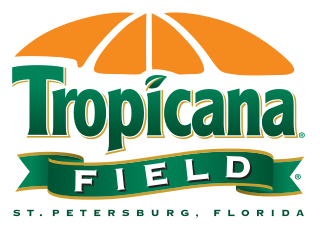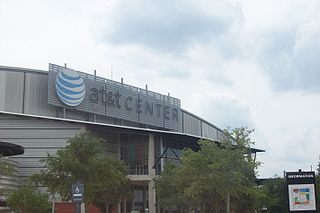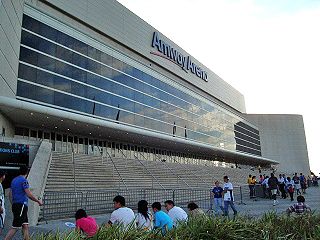
A stadium is a place or venue for (mostly) outdoor sports, concerts, or other events and consists of a field or stage either partly or completely surrounded by a tiered structure designed to allow spectators to stand or sit and view the event.

Moda Center, formerly known as the Rose Garden, is the primary indoor sports arena in Portland, Oregon, United States. It is used for basketball, ice hockey, rodeos, circuses, conventions, ice shows, concerts, and dramatic productions. The arena has a capacity of 19,393 spectators when configured for basketball. It is equipped with state-of-the-art acoustics and other amenities.

FedExField is an American football stadium located in Landover, Maryland, 5 miles (8.0 km) east of Washington, D.C. The stadium is the home of the Washington Commanders of the National Football League (NFL). From 2004 until 2010, it had the largest seating capacity in the NFL at over 91,000. As of 2021, the capacity had been reduced to 58,000. The stadium is owned by Josh Harris and is operated by the Commanders.

Tropicana Field is a multi-purpose domed stadium located in St. Petersburg, Florida, United States. The stadium has been the ballpark of the Tampa Bay Rays of Major League Baseball (MLB) since the team's inaugural season in 1998. The stadium is also used for college football, and from December 2008 to December 2017 was the home of the St. Petersburg Bowl, an annual postseason bowl game. The venue is the only non-retractable domed stadium in Major League Baseball, making it the only year-round indoor venue in MLB. Tropicana Field is the smallest MLB stadium by seating capacity when obstructed-view rows in the uppermost sections are covered with tarps as they are for most Rays games.

Camping World Stadium is an outdoor stadium in Orlando, Florida, United States located in the West Lakes neighborhood of Downtown Orlando, west of new sports and entertainment facilities including the Amway Center, the Dr. Phillips Center for the Performing Arts, and Exploria Stadium. It opened in 1936 as Orlando Stadium and has also been known as the Tangerine Bowl and Florida Citrus Bowl. The City of Orlando owns and operates the stadium.

United Center is an indoor arena on the Near West Side of Chicago, Illinois, United States. It is home to the Chicago Bulls of the National Basketball Association (NBA) and the Chicago Blackhawks of the National Hockey League (NHL). It is named after its corporate sponsor United Airlines, which has been based in Chicago since 2007. With a capacity of nearly 21,000, the United Center is the largest arena by capacity in the NBA, and second largest arena by capacity in the NHL. It also has a seating capacity of 23,500 for concerts.

Simmons Bank Liberty Stadium, originally named Memphis Memorial Stadium, and later Liberty Bowl Memorial Stadium, is a football stadium located at the former Mid-South Fairgrounds in the Midtown area of Memphis, Tennessee, United States. The stadium is the site of the annual Liberty Bowl, the annual Southern Heritage Classic, and is the home field of the University of Memphis Tigers football team of the American Athletic Conference. It has also been the host of several attempts at professional sports in the city, as well as other local football games and other gatherings.

Climate Pledge Arena is a multi-purpose indoor arena in Seattle, Washington, United States. It is located north of Downtown Seattle in the 74-acre (30 ha) entertainment complex known as Seattle Center, the site of the 1962 World's Fair, for which it was originally developed. After opening in 1962, it was subsequently bought and converted by the city of Seattle for entertainment purposes. From 2018 to 2021, the arena underwent a $1.15 billion redevelopment; the renovation preserved the original exterior and roof, which was declared a Seattle Landmark in 2017 and was listed on the Washington Heritage Register as well as the National Register of Historic Places in 2018. The renovated venue has a capacity of 17,151 for ice hockey and 18,300 for basketball.

Rocket Mortgage FieldHouse is a multi-purpose arena in Cleveland, Ohio. The building is the home of the Cleveland Cavaliers of the National Basketball Association (NBA) and the Cleveland Monsters of the American Hockey League (AHL). It also serves as a secondary arena for Cleveland State Vikings men's and women's basketball.

Frost Bank Center is a multi-purpose indoor arena on the east side of San Antonio, Texas, United States. It is the home of the San Antonio Spurs of the National Basketball Association.

State Farm Arena is a multi-purpose arena located in Atlanta, Georgia. The arena serves as the home venue for the National Basketball Association (NBA)'s Atlanta Hawks. It also served as home to the National Hockey League's Atlanta Thrashers from 1999 to 2011, before the team moved to Winnipeg, as well as the Women's National Basketball Association (WNBA)'s Atlanta Dream from 2008 to 2016 and 2019, and the temporary Home of the Georgia Tech Basketball in 2011. It opened in 1999 at a cost of $213.5 million, replacing the Omni Coliseum. It is owned by the Atlanta Fulton County Recreation Authority and operated by the Hawks, owned by Tony Ressler along with a group of investors including Grant Hill.

Amway Arena was an indoor arena located in Orlando, Florida. It was part of the Orlando Centroplex, a sports and entertainment complex located in Downtown Orlando. The arena was the former home of the Orlando Magic of the NBA and the Orlando Titans of the NLL. It was also the home of the Orlando Solar Bears of the International Hockey League, and the Orlando Predators of the Arena Football League. It also hosted many other minor league sports teams, as well as various concerts and other events such as the PlayStation Pro event on the Dew Action Sports Tour and the Ringling Brothers and Barnum and Bailey Circus annually.

The Wells Fargo Center is a multi-purpose indoor arena located in Philadelphia. It serves as the home of the Philadelphia Flyers of the National Hockey League (NHL), the Philadelphia 76ers of the National Basketball Association (NBA), and the Philadelphia Wings of the National Lacrosse League (NLL). The arena lies at the southwest corner of the South Philadelphia Sports Complex, which includes Lincoln Financial Field, Citizens Bank Park, and Xfinity Live!.

The Alamodome is a 64,000-seat domed indoor multi-purpose stadium in San Antonio, Texas. It is located on the southeastern fringe of downtown San Antonio. The facility opened on May 15, 1993, having been constructed at a cost of $186 million.

An auditorium is a room built to enable an audience to hear and watch performances. For movie theatres, the number of auditoria is expressed as the number of screens. Auditoria can be found in entertainment venues, community halls, and theaters, and may be used for rehearsal, presentation, performing arts productions, or as a learning space.

Jordan-Hare Stadium is an American football stadium in Auburn, Alabama on the campus Auburn University. It primarily serves as the home venue of the Auburn Tigers football team. The stadium is named for Ralph "Shug" Jordan, who owns the most wins in school history, and Cliff Hare, a member of Auburn's first football team as well as Dean of the Auburn University School of Chemistry and President of the Southern Conference. On November 19, 2005, the playing field at the stadium was named in honor of former Auburn coach and athletic director Pat Dye. The venue is now known as Pat Dye Field at Jordan-Hare Stadium. The stadium reached its current seating capacity of 88,043 with the 2023 expansion and is the 10th largest stadium in the NCAA and the 20th largest in the world. For years, it has been a fixture on lists of best gameday atmospheres and most intimidating places to play.

Paycom Center is an arena located in Downtown Oklahoma City, Oklahoma, United States. It opened in 2002 and since 2008 has served as the home venue for the National Basketball Association (NBA)'s Oklahoma City Thunder. Previously, the arena was home to the Oklahoma City Blazers of the Central Hockey League (CHL) from 2002 until the team folded in July 2009, and the Oklahoma City Yard Dawgz of AF2 from 2004 to 2009 when the team moved to the Prairie Surf Studios. In addition to its use as a sports venue, Paycom Center hosts concerts, family and social events, conventions, ice shows, and civic events. The arena is owned by the city and operated by the SMG property management company and has 18,203 seats in the basketball configuration, 15,152 for hockey, and can seat up to 16,591 for concerts.
Club-level seating is a special section of seating in modern sports stadiums and arenas.

John O'Quinn Field at TDECU Stadium is an American football stadium on the campus of the University of Houston. The stadium serves as the home of the Houston Cougars football team, which represents the University of Houston in collegiate football and the Houston Roughnecks of the XFL.

The Pit is an indoor arena in Albuquerque, New Mexico, serving primarily as the home venue of the University of New Mexico Lobos basketball teams. The facility opened in 1966 as University Arena but gained the nickname "The Pit" due to its innovative subterranean design, with its playing floor 37 feet (11 m) below street level. The arena is located on the UNM South Campus and has a seating capacity of 15,411 for basketball and up to 13,480 for concerts, with 40 luxury suites and 365 club seats.



















